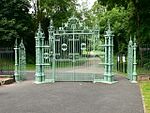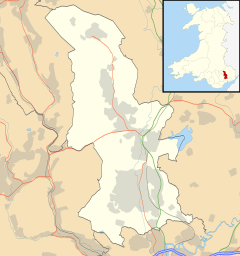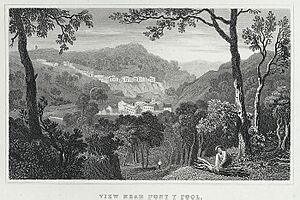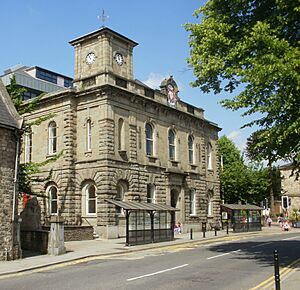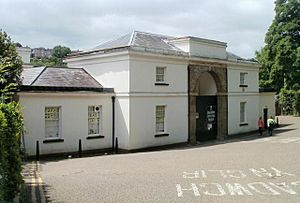Pontypool facts for kids
Quick facts for kids Pontypool
|
|
|---|---|
|
|
|
| Population | 29,062 |
| OS grid reference | SO285005 |
| Principal area |
|
| Ceremonial county | |
| Country | Wales |
| Sovereign state | United Kingdom |
| Post town | PONTYPOOL |
| Postcode district | NP4 |
| Dialling code | 01495 |
| Police | Gwent |
| Fire | South Wales |
| Ambulance | Welsh |
| EU Parliament | Wales |
| UK Parliament |
|
| Welsh Assembly |
|
Pontypool (Welsh: Pont-y-pŵl) is a town in South Wales. It is the main administrative center of the Torfaen area. Pontypool is located within the historic county of Monmouthshire. In 2021, about 29,062 people lived there.
Contents
Where is Pontypool?
Pontypool is located on the Afon Lwyd river in the Torfaen area. It sits on the eastern edge of the South Wales coalfields. The town grew because of industries like iron and steel making. Coal mining and the growth of railways also helped it expand. A special art industry called Japanning also thrived here. This was a type of lacquer work.
Pontypool includes several smaller areas and villages. These are New Inn, Griffithstown, Sebastopol (Panteg), Abersychan, Cwmffrwdoer, Pontnewynydd, Trevethin, Penygarn, Wainfelin, Tranch, Brynwern, Pontymoile, Blaendare, Cwmynyscoy, Talywain, Garndiffaith, Pentwyn, and Varteg.
Pontypool's Past: A Look at History
The Welsh name for the town is Pont-y-pŵl. This means 'bridge by the pool'. It comes from a bridge over the Afon Lwyd river. The word pŵl is borrowed from the English word 'pool'.
Pontypool is known as one of the first industrial towns in Wales. The area was a hub for new inventions and technology. Iron making started here as early as the 1400s. A special furnace was built at Pontymoile. In the 1500s, the Hanbury family helped the iron industry grow. By the 1600s, the town itself began to develop. For the next two centuries, metal, mining, canals, and railways helped Pontypool expand.
How Industry Shaped Pontypool
The Afon Lwyd valley had many resources needed for making iron. These included coal, iron ore, charcoal, and waterpower. New technologies in the Tudor period helped use these resources better. For example, blast furnaces were used to make iron. A blast furnace was used near Pontypool from 1536. More furnaces were built around the town. An ironworks was set up in what is now Pontypool Park around 1575. Forges, which turned cast iron into wrought iron, also appeared. These included Town Forge in Pontypool and Osborne Forge near Pontnewynydd.
Richard Hanbury, a businessman from Worcestershire, became interested in Pontypool in the 1570s. He bought and developed forges and furnaces. He also gained rights to use raw materials like wood for charcoal. He could also mine coal and iron ore from large areas. The Hanbury family also worked in other areas in the 1600s.
Major John Hanbury (1664–1734) was a leader in industry. Thanks to him and his team, big steps were made in the British tinplate industry. In 1697, the world's first rolling process for iron sheets was used at Pontypool Park. Tinplate was made in Pontypool from about 1706. An important tin mill operated at Pontymoile in the early 1700s.
In the 1660s, Thomas Allgood managed the Pontypool Ironworks. He created the Pontypool 'japanning' process. This method treated metal plates to give them a shiny, decorative finish. Thomas Allgood died in 1716. But his sons, Edward and Thomas, started a japanning factory in Pontypool. By 1732, they were making many Japanware items. They made beautiful bread baskets, tea trays, and dishes. Their work was known for its high quality. After Edward Allgood died in 1761, his sons had a disagreement. A new japanning factory was opened in Usk. Both factories stopped production by the early 1820s.
The Industrial Revolution brought huge economic growth to South Wales. Iron making boomed in towns like Merthyr Tydfil and Blaenavon. By the early 1800s, South Wales was the world's top iron producer. Pontypool focused on making special tinplate. The japanning industry here faded by the mid-1800s. The town's economy then relied on iron, coal, tinplate, and iron rails. In the 1900s, heavy industries in South Wales declined. This affected Pontypool's economy.
How Pontypool Grew as a Town
Pontypool grew as its industries developed. It started as a few scattered farms. Then, Trosnant and Pontymoile began to grow. As industry focused on Pontypool, it became the main center for the area.
Pontypool was a small village in the old Trevethin parish. In 1690, the Crown allowed a market to be set up in Pontypool. This meant a weekly market and three yearly fairs. The village officially became a town. A market hall was built in 1730–31. This raised the town's importance. The Hanbury family also developed their Pontypool Park estate as their home. New industrial jobs led to houses being built along the Afon Lwyd. Trade also grew. Pontypool became known for clock-making in the 1700s.
By the mid-1700s, Pontypool was a small town. It offered jobs, homes, and shops. It was also an important local center. By the early 1800s, Pontypool had about 250 houses. It had many busy shops and businesses. About 1,500 people lived there.
Pontypool kept growing in the 1800s. Many new houses and buildings were built. Nearby villages also grew, becoming like suburbs of Pontypool. Important public buildings were added. These included many chapels and churches. Pontypool Town Hall was built in 1856. Many shops, banks, pubs, hotels, and a public library (from 1906) also appeared.
The town also became important for education. A Welsh Baptist College moved to Pontypool in 1836. It trained many Welsh Baptist ministers. The college moved to Cardiff in 1893. The old college building became the County Grammar School for Girls in 1897. In January 1898, West Monmouth Grammar School opened for boys. This school's history goes back to the 1600s. William Jones, a rich merchant, left money for charity and education in Monmouth. Monmouth School was built in 1615. Later, the charity decided to build more schools. 'West Mon' School was built for £30,000. John Capel Hanbury gave the land in 1896.
Town growth continued in the 1900s. New housing schemes improved homes for working-class families. Later, old streets and buildings were removed. New roads were built to handle more traffic.
Getting Around: Transport in Pontypool
Industries needed good ways to move goods. A network of tramroads was built around Pontypool. These connected mines to factories and then to markets. The Monmouthshire Canal was built in the 1790s. It linked Pontnewynydd to Newport. It later connected with the Brecknock and Abergavenny Canal at Pontymoile in 1812. Tramroads from industrial areas met at Pontnewynydd or Pontymoile.
Railways replaced tramroads and canals in the mid-1800s. Work began in 1845 on a railway from Pontypool to Newport. It opened for passengers in 1852. It connected to Blaenavon in 1854. This line later became part of the Great Western Railway. Another line was built in the 1860s and 1870s. It connected Pontypool with Newport via Caerleon. Connections were also made to Abergavenny, Hereford, and Taff Vale. Pontypool had three railway stations: Crane Street, Clarence Street, and Pontypool Road. Many lines closed in the 1960s. Modern roads replaced them. Today, the only passenger line in Pontypool is at a station in New Inn. Pontypool & New Inn station is on the Welsh Marches Line. Trains are run by Transport for Wales.
Pontypool Park: A Place for Everyone
Pontypool Park was the historic home of the Hanbury family. They built their main home in Pontypool around 1694. Major John Hanbury then created a deer park in the early 1700s. The park was used for fun by the Hanbury family and their friends. An example of their fancy style is the shell grotto summerhouse. It was finished and decorated in the 1830s.
Pontypool Park House was made bigger and changed over time. Major changes happened in the mid-1700s, early 1800s, and 1872. The park itself was also changed in the 1800s. The old ironworks were removed in 1831. The park gates were rebuilt in 1835. Trees were planted to give the family more privacy. The American Gardens were developed in 1851.
In 1920, the house and park became public property. This allowed it to be used by everyone. In the 1920s, public tennis courts, a rugby ground, and a bowling green were added. The Royal National Eisteddfod, a big Welsh festival, took place here in 1924. A bandstand was added in 1931. This let people listen to music outdoors. A leisure center and an artificial ski slope were built in 1974.
Pontypool Park House was sold in 1923. It became a girls' boarding school. Later, it became St. Alban's R.C. High School. The building next to it, the stable block, was used for different things. In 1981, it became the Valley Inheritance Museum. This museum collects and shows items about the history of the Afon Lwyd valley.
Learning in Pontypool: Education
Pontypool has four main high schools:
- Abersychan School
- West Monmouth School (once a grammar school for boys)
- St. Alban's R.C. High School
- Ysgol Gymraeg Gwynllyw, a Welsh language school for students aged 3 to 19.
Trevethin Community School closed in 2007. This used to be the Pontypool Grammar School for Girls. It was also the first site of the Welsh Baptist College.
Pontypool Campus Coleg Gwent closed permanently in 2023. It was used as a vaccination center during the COVID outbreak. The local council is now thinking about building houses there.
Crownbridge Special School was in Pontypool. But in 2012, it moved to new buildings in Cwmbran.
Fun and Games: Sport and Leisure
Pontypool Active Living Centre is in Pontypool Park. It is the only place in Pontypool with a swimming pool. It has a 25-meter pool for swimming competitions. There is also a separate teaching pool and two waterslides. The center also has a fitness room, a strength training room, a dance studio, and a sports hall.
Pontypool Park is home to Wales' oldest and longest artificial ski slope. It was built in 1974 and is 230 meters long. It is used for fun and for training by the Welsh Ski Squad. The ski slope is closed for part of the year due to money cuts.
In Pontypool Park, there is also a play park for children and a skate park. There is a picnic area and outdoor tennis courts.
Pontypool RFC’s rugby ground is also in Pontypool Park.
Pontypool has a prize-winning Brass Band. They performed in the finals of the National Brass Band Championships of Great Britain in 2012 and 2013.
Rugby in Pontypool

Pontypool Rugby Football Club is a very important part of the town. It was started in the 1870s. The club helped create the Welsh Rugby Union in 1881. Under captain Terry Cobner, 'Pooler' became one of the best Welsh rugby teams. The famous 'Pontypool Front Row' from the 1970s was made up of Bobby Windsor, Charlie Faulkner, and Graham Price. They were even celebrated in a song! In 1983, five players from Pontypool were in the Welsh team for the Five Nations Championship.
Other rugby clubs nearby include Pontypool United RFC, Abersychan RFC, Garndiffaith RFC, New Panteg RFC, Talywain RFC, West Mon RFC, Blaenavon RFC, and Forgeside RFC. Pontypool's rugby league team is called the Torfaen Tigers. They play in the Rugby League Conference Welsh Premier.
Football in Pontypool
Here are some football teams in the area:
- Blaenavon Blues, Blaenavon
- Fairfield United F.C., Garndiffaith
- Forgeside AFC, Blaenavon
- Griffithstown AFC, Griffithstown
- Panteg AFC, Panteg
- PILCS AFC, New Inn
- Pontnewynydd AFC
- Pontypool Town AFC
- Race AFC, Blaendare
- Tranch AFC, Tranch
Places to See in Pontypool
- Big Pit National Coal Museum
- Blaenavon Ironworks
- Blaenavon Heritage Railway -Pontypool and Blaenavon Railway
- Llandegfedd Reservoir
- Monmouthshire and Brecon Canal
- Pontypool Park
- Folly Tower, Pontypool
- Shell Grotto, Pontypool
- Pontymoile Basin
- Torfaen Museum
Famous People from Pontypool
- See also Category:People from Pontypool
Arts and Literature
- Aimee-Ffion Edwards – actress
- Annabel Giles – model and presenter
- Anthony Hopkins – actor
- David Llewellyn – writer
- Dame Gwyneth Jones – opera singer
- Jane Arden – film-maker, writer, and poet
- James Dean Bradfield – singer and guitarist for Manic Street Preachers
- Jennifer Daniel – actress
- Keri Collins – screenwriter
- Kevin Owen – TV news anchor
- Lee Dainton – from the TV show Dirty Sanchez
- Luke Evans – actor and singer
- Peredur ap Gwynedd – guitarist for Pendulum
- Myfanwy Haycock – poet
- Steve Parry – musician from the band Hwyl Nofio
- Thomas Barker – painter
Business and Education
- Edwin Stevens – invented the first hearing aid
- David Gwilym James – Vice-Chancellor of the University of Southampton (1952-1965)
- Rhys Probert – Director of the Royal Aircraft Establishment (1973-1980)
Clergy
- Elzear Torreggiani – Capuchin friar and later bishop
- Frank and Seth Joshua – Welsh Revival Evangelists
- Noel Debroy Jones – Bishop of Sodor and Man
- Sarah Clark, Bishop of Jarrow
- Morgan Edwards – historian of religion
Public Service
- Alun Gwynne Jones, Baron Chalfont, politician
- Don Touhig – politician
- Joan Ruddock – politician
- Ivor Bulmer-Thomas – politician
- Paul Murphy – politician
- Roy Jenkins – politician
- Nick Thomas-Symonds – politician, lawyer, and academic
- Steffan Lewis – politician
- Theodore Huckle – Counsel General for Wales
- William Jones – (1809–1873), a Chartist leader
Sport
- Allen Forward – rugby player
- Aneurin Owen – rugby player
- Bryn Meredith – rugby player
- Caleb McDuff – racing driver
- Cerys Hale – rugby player
- Ellie Curson – professional footballer
- Gareth Maule – rugby player
- Graham Price – rugby player
- Iestyn Thomas – rugby player
- James Waite – football player
- Ken Jones – rugby player
- Lloyd Burns – rugby player
- Luca Hoole – football player
- Mako Vunipola – rugby player
- Marcus Ebdon – footballer
- Mark Taylor – rugby union player
- Ryan Doble – footballer
- Taulupe Faletau – rugby player
- Terry Cobner – rugby player
- Tony Villars – footballer
Nearby Areas
 |
Wainfelin | Pontnewynydd | Trevethin |  |
| Tranch | Pen-y-garn | |||
| Lower Race | Griffithstown, Cwmbran | Pontymoile, New Inn |
Sister Towns
Pontypool is connected with these towns:
- Condeixa, Portugal (since 1994)
- Bretten, Germany (since 1994)
- Longjumeau, France (since 1994)
All four towns are linked together. They hold a twinning conference and youth festival each year in one of the towns.
See also
 In Spanish: Pontypool para niños
In Spanish: Pontypool para niños




